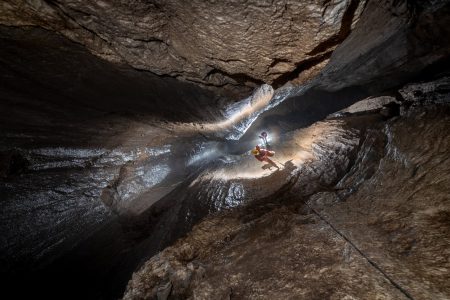Largely because of sensationalized press coverage on the rare occasions when serious incidents happen, caving is seen by many as a dangerous sport. This perception, however, is not supported by objective evidence. The obvious risks can all be managed with an appropriate combination of equipment, technique, and preparedness. In fact, in terms of injury rates per hour of participation, caving compares favourably with many other sports.
While public perception of caving may be that it is a dangerous and elite sport, the true picture is that it is safe, inclusive for a wide range of abilities, and offers many physical and mental health benefits.

Specifically with reference to the remit of the Ghar Parau Foundation, expedition caving serves not only to advance the development of the expedition team members through teamwork, leadership, and training, but participants also gain valuable experience and knowledge of cave science. The advancement of equipment and techniques, together with the aspirational pull of original exploration in remote locations, is reflected back into the sport to the benefit of all its participants.
That said, The Ghar Parau Foundation thinks it is important to recognise the value of risk assessments in managing both the obvious and the less obvious risks of caving expeditions. We encourage all expeditions to perform a risk assessment but we don’t actually review them as part of the application process and your expedition won’t be marked up or down for an award on the basis of your risk assessment.
Any risk assessment has to identify things that are likely to happen and things that are unlikely to happen, as well as to identify whether a hazard presents the possibility of severe or minor consequences. A hazard with severe consequence (usually, but not always, bodily injury) but which is very unlikely to happen actually presents a lower risk than a hazard that has less severe consequences but is more likely to occur. Low-consequence events that happen regularly are usually managed as a matter of course, and in caving there are some high-risk hazards that are common (examples being high rainfall and falls from a height) and so the appropriate protection measures are also well understood.
Therefore, the primary value of risk assessments is in identifying less frequent, usually serious events, and ensuring that you are prepared for them when they occur. However, low-consequence events which happen infrequently must also be considered and it’s important not to take for granted the protection measures for the common high-risk hazards.
Risk assessments do not need to be long or complicated, and you don’t need to assign numbers to hazards, frequency, etc – sometimes numbers help, but more often than not they make the process more complicated by introducing arguments about where to draw the lines when choosing scores. Remember, the primary function of a risk assessment is to identify risks in advance so you are prepared to deal with them when they arise, or so you can see them coming and avoid them.
Three examples of a caving risk assessment are linked below:
We are grateful to Oxford University Caving Club, Imperial College Caving Club, and Tim Allen and Mark Wright of the Mulu Caves Project for allowing us to use their risk assessments as examples.
Please review them and adapt them where you think they are useful but don’t just copy them: the main benefit of risk assessment is in the process itself, not just the documented outcome.
If you have a risk assessment you are prepared to share, please send us a copy and we’ll add it to the list above.